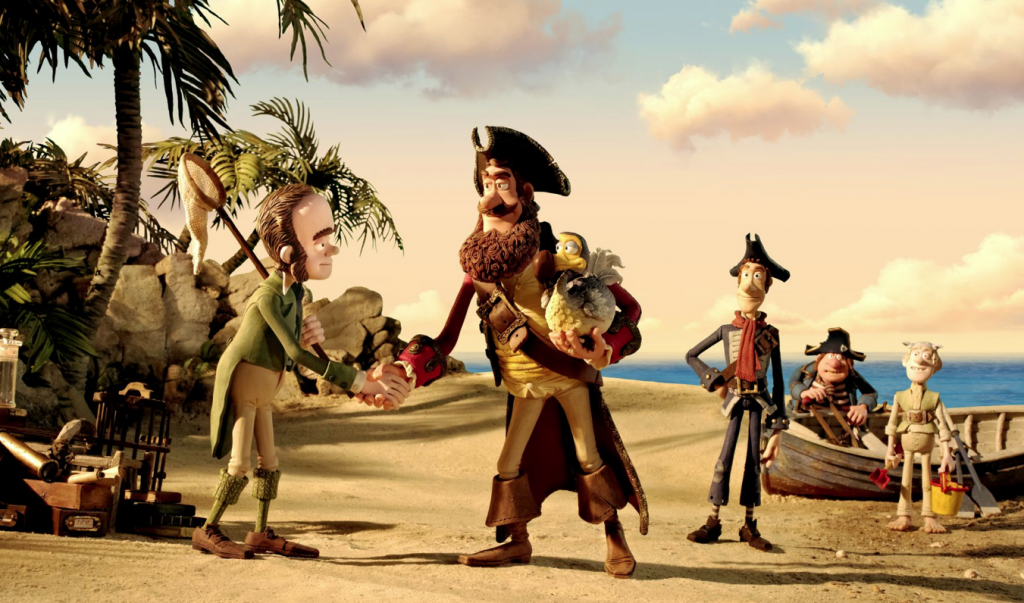
Figure 1-The Pirate Captain and his dodo comrade Polly embrace Charles Darwin.
Aardman never shy away from the ludicrous. So when a crew of incompetent pirates endeavour for protagonist The Pirate Captain to win the Pirate of the Year Award by relying on the commercial value of his prized dodo companion Polly (who should have been extinct for 150 years and is believed to be a parrot) to gain riches from Queen Victoria, all whilst accompanied by a devious Charles Darwin (who is in love with said Queen) and his pet “manpanzee,” Peter Lord more than accomplishes similar levels of Aardman-esque ludicrousness in Pirates! In an Adventure with Scientists! (2012). Eventually, Victoria is revealed as the evil organiser of a rare animal eaters’ club, relishing the prospect of devouring Polly before the pirates and Charles rescue the dodo.
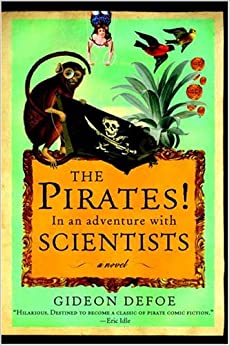
Reimagining Gideon Defoe’s children’s novel of the same title (figure 2), Lord delivers another ebullient family-friendly, stop-motion and Claymation adventure-comedy, as always catering for children, with the amusing, giddy mannerisms of The Pirate Captain, and for adults, for instance when Charles’ intellectual sidekick chimpanzee Mr Bobo plays the drums of ‘Also Sprach Zarathustra’ in reference to the opening of Kubrick’s 2001: A Space Odyssey (figure 3). Anthropomorphising the animated animal like Polly and Mr Bobo facilitates these absurd and subversive portrayals to appear sane due to animation’s playful nature which, as Paul Wells compellingly devises, is adept at “challenging and…redefining” knowledge “about apparently specific creatures…or even human figures,” as comedy and a fast-paced plot distracts viewers from the ridiculous.[1] Audiences are subsequently enchanted by not only the humour, preposterousness, and engaging with Aardman’s meticulous detail and artistry, but feel affection towards this “redefined” human-animal relationship whereby the dodo and chimpanzee ostensibly belong in the human world, with anthropomorphism reducing the “strangeness in taxonomy.”[2]
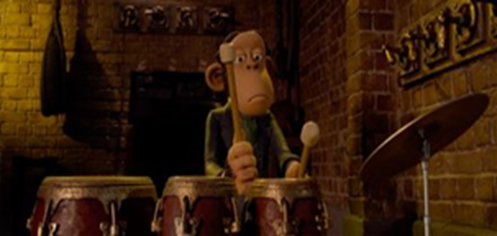
However, it’s never that simple with Aardman. Whilst the foreground depicts this accepting, egalitarian world that narrows the culturally normalised human-animal binary, loitering in the background is satirical criticism of humans who believe they are supportive and welcoming to animals, but their anthropocentric avaricious motivations undermine this. In the context of the Queen’s “secret dining society” and Charles’ implied experimentation on animals, as well as the early 2010s increasing awareness of humanity’s impact on animal extinction (the UN declared the 2010s as “The Decade on Biodiversity”[3]), Pirates!, akin to Creature Comforts and Chicken Run, valuably denounces humans in positions of assumed authority for underestimating the importance of animals, specifically condemning humanity’s negligence towards animal preservation, generating a pretence of animals being welcomed and treated as equals in the human realm.
“she’s like an auntie, with a beak”
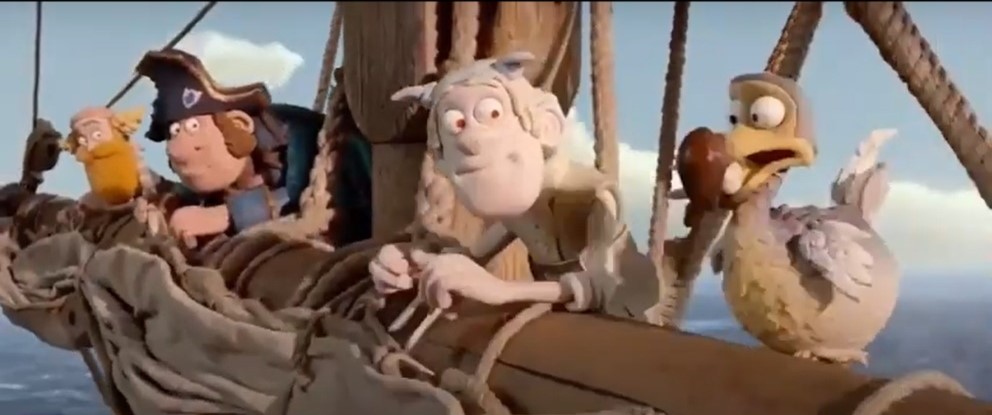
Figure 4-Polly helps her crewmates attach the sail to the ships’ mast.
This is immediately in play through Polly’s introduction: the alleged “feathery heart and soul of the boat,” pictured raising the sail alongside shipmates in figure 4. Whereas some of the pirates are unmemorable at the beginning, Polly is glorified, imitating a catwalk when she struts down the table and dictates the camerawork which is centre-frame at her eye level (figure 5).
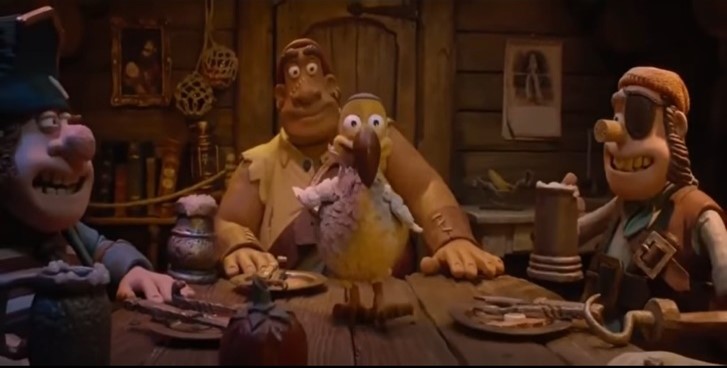
Figure 5-a revered Polly waltzes down the table.
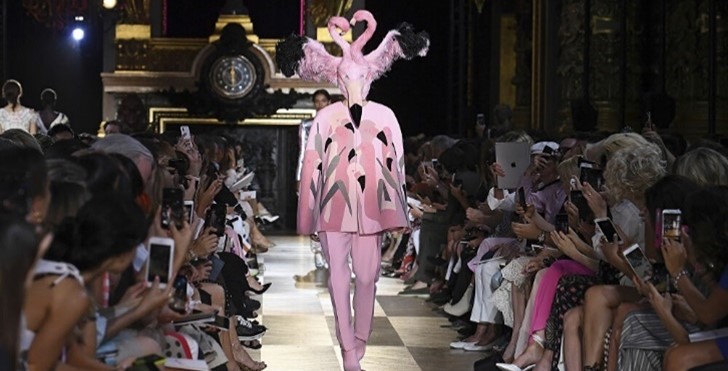
Figure 6-a model flaunting their flamingo costume at Paris Fashion Week 2019.
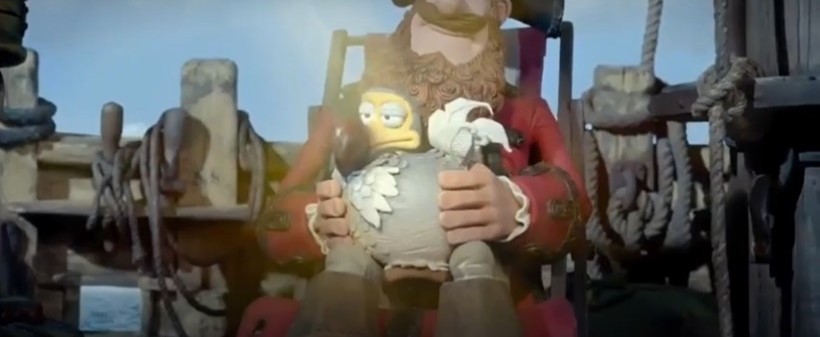
This introduction and favourable exposure to the camera implies agency and belonging, anthropomorphising Polly through her smile and by partaking in the ship’s upkeep. Consequently, she appears more than just a pet but a crucial and equal part of the ship. Furthermore, when Charles first witnesses Polly, Lord positions the audience from his point-of-view with angelic extra-diegetic music and a spotlight from above exalting her in figure 7.
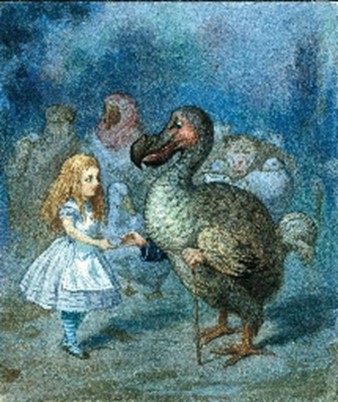
However, in a quintessentially Aardman style, such glorification comes across as ironic, mocking the celebrity status of the dodo. Set in 1837, Pirates! coincides with the rise of the dodo’s celebrity status with contemporary releases like Alice’s Adventures in Wonderland (figure 8). Rather than promoting animal preservation awareness, the dodo became a caricature for something languid, leaving many conservationists to “hope that there will not be many other such icons in the future.”[4] Lord utilises this discourse via deliberately ironic and cliched fetishization of Polly, with the purported affection and equal treatment of her appearing comical, sarcastic and condescending, particularly by forcibly submerging audiences from Charles’ glorified point-of-view. This humour enhances the satire of humanity not recognising the seriousness of animal preservation, as both the pirates and Charles instantly seek to iconise and create a celebrity out of Polly instead of conserving her.
“What we had for dinner today would sound very odd in England—ostrich and armadillos” – Charles Darwin’s Beagle Diary [5]
The lovestruck Charles covets Polly to impress his crush: the obvious choice for Aardman being Queen Victoria. David Tennant who voices Charles highlights he’s “Machiavellian” and “not historically accurate” in a promotional interview. Animation permits this “redefined,” unexpectedly devious Charles who craves the dodo for personal reasons instead of protecting or scientifically examining her. Yet this representation of the scientist is astonishingly somewhat accurate. Not to discredit Darwin’s remarkable studies, but Victoria’s rare animal eaters’ club alludes to the real life ‘Glutton Club’ founded by Darwin and his Cambridge University peers who hunted, cooked and ate peculiar animals “unknown to the human palate.”[6] Later, onboard The Beagle, Diana Noyce postulates Darwin spent more time on land finding “delicacies” and prioritising gastronomical endeavours alongside his notorious scientific ventures.[7] Reimagining Charles as a more menacing figure in relation to animals subverts audiences’ preconceptions by underlining how both the real and the film’s Darwin didn’t sincerely care for animal preservation. Therefore, when initially encountering him in Pirates!, Lord creates an ironic gag when The Pirate Captain believes Charles’ “baboon’s kidney” is “gold,” symbolising and foregrounding Charles’ surprisingly materialistic outlook on animals.
“just an old project of mine […] he would cease to become a monkey and become more of a manpanzee”
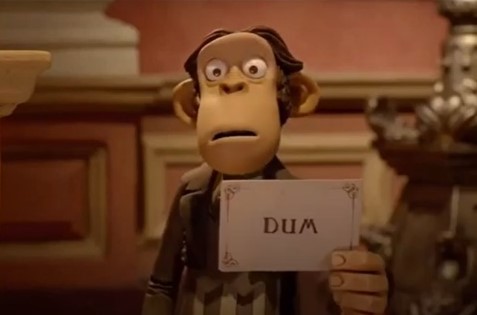
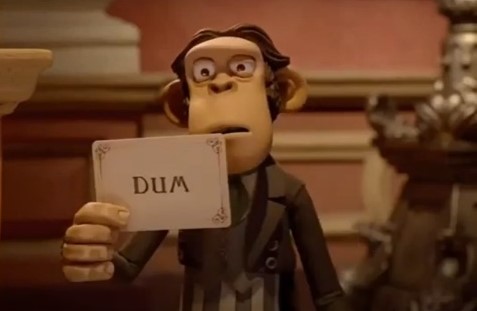
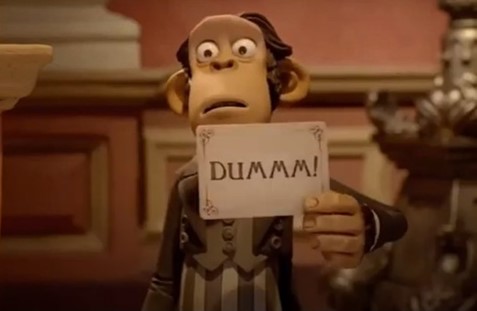
This exploitative “Machiavellian” Charles is paramount to understanding the problematic relationship with his “manpanzee” Mr Bobo. Facilitated by animation’s fluidity and playfulness, including enacting conventions of the horror and Victorian Gothic with the pirates’ first approach to Charles’ spooky mansion from a daunting point-of-view shot accompanied by ominous extra-diegetic music, the film has a persistent theme of conniving experimentation. So when Charles brands Mr Bobo as his “project,” this implication of sinister experimentation on animals applies the Romantic-Victorian notion of going beyond the humanly feasible and presuming authority over the ‘other’ to valuably challenge whether modern audiences still partake in this presumption. A consequence of Charles’ implied experimentation is that Mr Bobo uses flashcards to speak and create humour (figure 10). This highlights Mr Bobo’s voicelessness, and despite Charles seemingly imposing human qualities onto the “manpanzee” to reduce the human-animal taxonomic distinction, this is done to claim authority over Mr Bobo. Charles regularly abuses this, for example ordering him to steal the dodo from The Pirate Captain. Yet through these moments of silent comedy, the audience mirrors Charles in a position of exploiting animals, taking advantage of their superior status in the human-animal hierarchy to laugh at Mr Bobo’s jokes. If it was a live action film displaying a monkey who’d been experimented on, this wouldn’t provoke a humorous reaction. Animation ensures the ludicrous, and in this case the sinister, comes across as justifiable, illuminating this pretence of animals belonging as equals in human society.
“you’re not-er-related in some way, are you?”
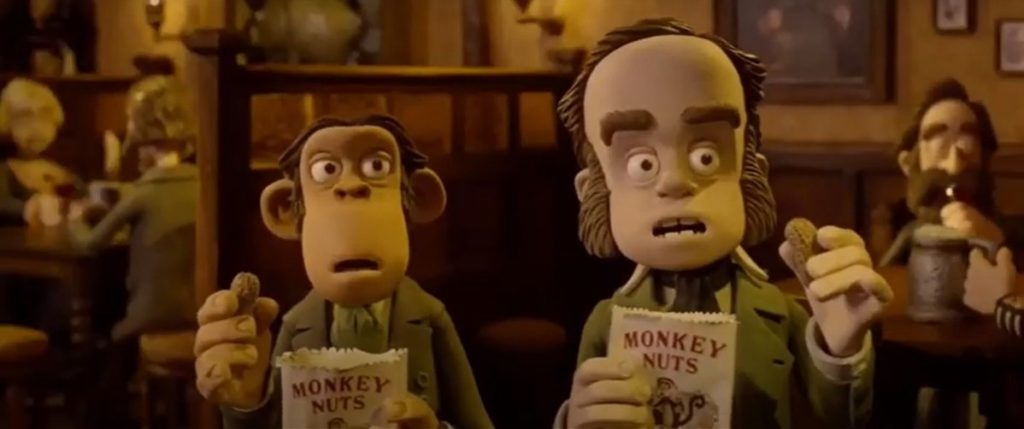
Figure 11-Charles and Mr Bobo eating ‘monkey nuts’ at the pub.
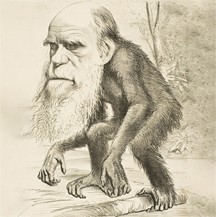
Charles’ resemblance to Mr Bobo again plays with the idea of the celebrity. Representations of him in the 19th Century “exclusively associated Darwin” with the ape in a way that was “so quickly identifiable”[8]-an idea that still exists today. Pirates! brings to life this caricature seen in 19th Century cartoons (figure 12) that was a means to simultaneously celebrate and explain his theory whilst criticising readers for not appreciating humans and animals’ interconnectedness. The persistent humour of Charles resembling Mr Bobo (figure 11) such as the “manpanzee” wearing clothes and Charles’ monkey-like physical features, reiterates emerging discussions from the 1800s that humans and animals were biologically and inextricably connected beings, contesting whether humans should assume authority over animals. Thus, the film astutely repeats the 19th Century’s cartoon satire, usefully condemning audiences for not taking the idea of human and animal similarity seriously enough via the novel device of reinstating satirical commentary from the past.
Additionally, Charles’ sinisterness is heightened as his house is littered with taxidermic and skeletal animals. As attentive as ever, this favoured Aardman technique of “creating a veneer of whimsy, innocuousness, and amusing distraction” in the foreground “while engaging in highly insightful observations about human foible and ignorance” in the background[9] generates a visual-zaniness whereby the critical commentary in the mise-en-scene undermines the explicit action and comedy. For instance, the proliferation of taxidermic animals at Charles’ house are covertly anthropomorphised more so than just via stuffing. Comedy is constructed through their eyes and eyebrows physically moving (figure 13), advancing the satire by juxtaposing the pirates and Charles’ campaigning for Polly’s protection with the resurrection of taxidermic animals. By enforcing conventional human qualities onto, and encouraging laughter from, dead animals, this blurring of dead and alive undermines the foregrounded advocation to protect Polly by constructing this “veneer of whimsy.” The audience being amused at such ludicrousness singles them out as habitually subordinating their attention to animals for personal goals akin to the pirates and Charles’ anthropocentricity and rapaciousness, such as The Pirate Captain using Polly to win Pirate of the Year and Charles’ desire to flatter the Queen by winning Scientist of the Year. This presentation of humanity’s relationship with animals enabled by animation’s playfulness valuably holds a mirror up to the human audience of their “foibles and ignorance,” doubting that their consideration for the protection of animals is genuine.
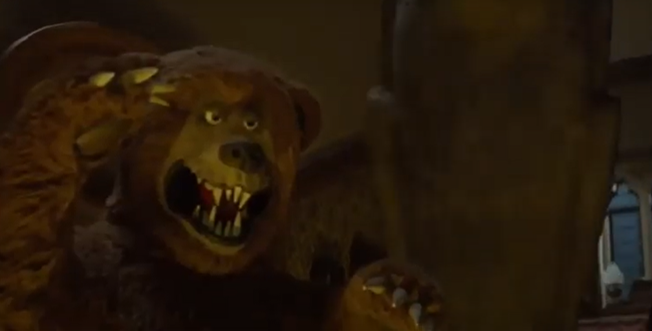
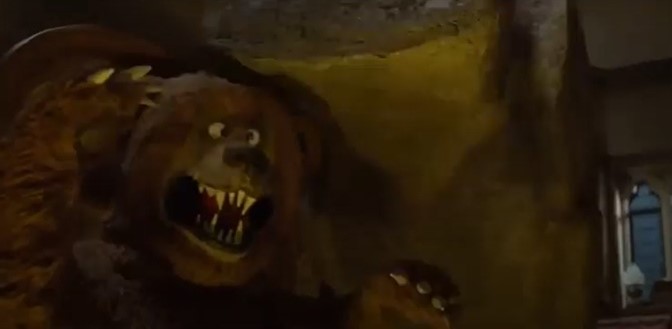
“this year, the highlight is dodo a l’orange”
Another occasion where the background mise-en-scene demeans the major action of the film is during the ending kitchen scene onboard the “secret dining society’s” flagship. Lord ostensibly displays the anthropomorphised shaking and wide-eyed, concerned-looking animals next in line to be cooked for amusing effect (figure 14). Yet, like the taxidermic animals, the comedy of anthropomorphism is undermined by the gravity of the situation, again rendering this shot a “veneer of whimsy.” Lord comments: “If Queen Vic’s dinner menu reads like the WWF endangered list, that’s because it is.”[10] Thus, this medium shot magnifying upon endangered animals (notice the Great Auk penguin) prior to them being eaten should be treated with greater sincerity, distancing audiences from the animals by situating them from the raised, superior point-of-view of the flagship’s chef belittling them. All we are encouraged to do however is laugh, cannily criticising the audience who equally don’t take animal preservation seriously enough. Lord’s remarks elucidate he self-consciously pondered upon these issues during the filming of Pirates!, manipulating the playful nature of anthropomorphism to accentuate the animal’s sentience which is juxtaposed with humanity’s “foiable and ignorant” laughter, thereby reemphasising the mirage of genuinely caring for animal preservation.
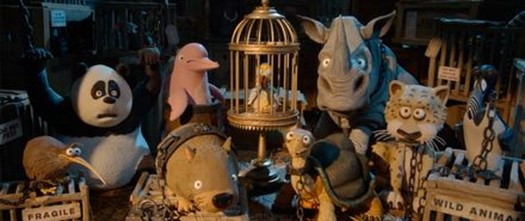
Overall, with humanity exploiting the dodo’s rarity and experimenting on animals for personal gain, alongside the film’s underbelly exhibiting the importance of animal preservation, Lord is heavily critical of humanity’s acquisitiveness in the film. Even though humanity believes it does, we don’t genuinely take animal preservation seriously enough, exemplified by the film’s pretence of welcoming animals into the human realm such as Mr Bobo’s relationship with Charles and Polly’s with, let’s face it, just about every human. Humour and whimsy through anthropomorphism intensifies this satire, forcing the audience to laugh at their own ignorance. But Lord’s most compelling achievement with Pirates! is to recall satire from the Victorian era. Both now and when the film was set there were crucial conversations of human-animal relations. The cliched celebrity presentations of Darwin and the dodo as well as the enduring theme of Charles’ experimentation with taxidermy and Mr Bobo repeats such satirical commentary. Enabled by animation’s ability to transcend the boundaries of time, this repeated satire invaluably holds a mirror up to modern audiences, insinuating that humanity’s lackadaisical perspective towards animals hasn’t changed drastically enough despite centuries passing. Whether it is royalty, scientists or pirates, humans still subordinate ecological considerations for personal ones. Within the film’s diegesis and external to it, animal preservation is never the priority.
This is why although anthropomorphism occurs in the film, it is more subtly deployed in Pirates! compared to other Aardman productions where animals are eponymous protagonists (Gromit) or actually speak (Chicken Run). Anthropomorphism in the film does create a human closeness with animals, rendering them typically ‘human’ enough for audiences’ empathy. But by not relying on overwhelming anthropomorphism, this delicately distances the audience from animals, situating viewers in an awkward middle-ground of intimacy and detachment. This awkwardness resembles humanity’s reluctance to commit to sincere animal preservation, an intriguing and beneficial way to look at human-animal relations that shrewdly blames the viewer for maintaining the human-animal binary.
References
[1] Paul Wells, The Animated Bestiary: Animals, Cartoons, and Culture., 1st ed. (Piscataway: Rutgers University Press, 2008), p. 5.
[2] Gill Bliss, ‘Redefining the Anthropomorphic Animal in Animation’ (unpublished Doctor of Philosophy thesis, University of Loughborough, 2016), p. 32.
[3] United Nations, ‘Taking Action on Biodiversity’, United Nations Decade on Biodiversity, 2011 <https://www.cbd.int/2011-2020/about>. [accessed 28 December 2021].
[4] Samuel T. Turvey & Anthony S. Cheke, ‘Dead as a Dodo: The Fortuitous Rise to Fame of an Extinction Icon’, Historical Biology, 20.2 (2008), 149-163 <https://doi.org/10.1080/08912960802376199> (pp. 160).
[5] R. D. Keynes, Charles Darwin’s Beagle Diary ed. By R.D. Keynes (Cambridge: Cambridge University Press, 1988) p. 105.
[6] Francis Darwin, Life and Letters of Charles Darwin, Vol. I (London: John Murray, 1887), p. 170.
[7] Diana Noyce, ‘Charles Darwin, the Gourmet Traveler’, Gastronomica , 12. 2 (2012), pp. 45-52, <https://www.jstor.org/stable/10.1525/gfc.2012.12.2.45> p. 49-50.
[8] Janet Browne, ‘Darwin in Caricature’ in The Art of Evolution: Darwin, Darwinisms, and Visual Culture, ed. By Barbara Larson (New Hampshire: University Press of New England, 2009) pp. 18-39 (p. 30-31).
[9] Paul Wells, The Animated Bestiary: Animals, Cartoons, and Culture., 1st ed. (Piscataway: Rutgers University Press, 2008), p. 165.
[10] Phil De Semlyen, ‘20 Pirates! Easter Eggs You Might Have Missed’, Empire, 2012 <20 Pirates! Easter Eggs You Might Have Missed | Movies | Empire (empireonline.com)> [accessed 7 January 2022].
Bibliography
Bliss, Gill, ‘Redefining the Anthropomorphic Animal in Animation’ (unpublished Doctor of Philosophy thesis, University of Loughborough, 2016).
Browne, Janet, ‘Darwin in Caricature’ in The Art of Evolution: Darwin, Darwinisms, and Visual
Culture, ed. By Barbara Larson (New Hampshire: University Press of New England, 2009) pp. 18-39.
Darwin, Francis, Life and Letters of Charles Darwin, Vol. I (London: John Murray, 1887).
Defoe, Gideon, The Pirates! In an Adventure with Scientists, a Novel (New York: Pantheon Books, 2004).
De Semlyen, Phil, ‘20 Pirates! Easter Eggs You Might Have Missed’, Empire, 2012 <20 Pirates! Easter Eggs You Might Have Missed | Movies | Empire (empireonline.com)> [accessed 7 January 2022].
Noyce, Diana, ‘Charles Darwin, the Gourmet Traveller’, Gastronomica, 12. 2 (2012), pp. 45-52, <https://www.jstor.org/stable/10.1525/gfc.2012.12.2.45>.
SFXarchive, David Tennant On The Pirates! In an Adventure with Scientists, online video recording, YouTube, 19 October 2012 <David Tennant On The Pirates! In an Adventure with Scientists – YouTube> [accessed 2 January 2022].
The Hornet, 22 March 1871.
Turvey, Samuel T. & Cheke, Anthony S., ‘Dead as a Dodo: The Fortuitous Rise to Fame of an Extinction Icon’, Historical Biology, 20.2 (2008), 149-163.
United Nations, ‘Taking Action on Biodiversity’, United Nations Decade on Biodiversity, 2011 <https://www.cbd.int/2011-2020/about>. [accessed 28 December 2021].
Wells, Paul, The Animated Bestiary: Animals, Cartoons, and Culture., 1st ed. (Piscataway: Rutgers University Press, 2008).
Further Reading
Burt, Jonathan., Animals in Film (London: Reaktion, 2002).
Carroll, Lewis, Alice’s Adventures in Wonderland (London: Macmillan, 1865).
Freeman, Carol, ‘Extinction, representation, agency: the case of the dodo’, in Considering Animals. (New York: Routledge, 2016) pp. 169-184.
Holterhoff, Kate, ‘Liberal Evolutionism and the Satirical Ape’, Journal of Victorian Culture: JVC, 21.2 (2016), 205–25.
Lawrence, Natalie, ‘Assembling the dodo in early modern natural history’, The British Journal for the History of Science, 48.3 (2015) 387-408.
Ratelle, Amy, Animality and Children’s Literature and Film, 1st edition. (Houndmills, Basingstoke, Hampshire; New York, NY: Palgrave Macmillan, 2015).
Smith, Jonathan, Charles Darwin and Victorian visual culture, Vol. 50 (Cambridge: Cambridge University Press, 2006).
Filmography
Kubrick, Stanley, dir., 2001: A Space Odyssey (Metro-Goldwyn-Mayer, 1968).
Lord, Peter, dir., Pirates! In an Adventure with Scientists (Columbia Pictures, 2012).
Lord, Peter & Park, Nick, dir., Chicken Run (Pathe Distribution Ltd., 2000).
Park, Nick dir., Creature Comforts (Channel 4, 1989).
Nick Park dir., Wallace and Gromit: A Grand Day Out (BBC, 1990).